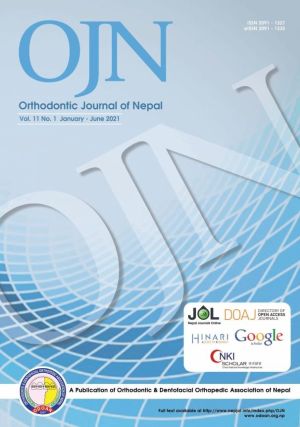A study on orthodontic retention practices in Nepal
DOI:
https://doi.org/10.3126/ojn.v11i1.39075Keywords:
Nepal, Orthodontics, Retainer, SurveyAbstract
Introduction: Retainers are used after all orthodontic treatment, to prevent or minimize relapse and recurrence. Among various retainers used, Hawley retainer and ‘invisible’ retainers are the most common. Most of the orthodontists favored permanent retention. It is obvious that the retention procedures are variable and depended largely on personal preferences, and there does not seem to be any consistent pattern in the application of retention methodologies. The purpose of this study was to survey the retention protocols among orthodontists in Nepal.
Materials and Method: The complete lists of the names and addresses of orthodontists in Nepal was obtained from the ODOAN. The questionnaire was sent to them which consisted of multiple-choice questions and short answer, related to background information of the individual orthodontist, retention use in general, the frequency of different types of bonded or removable retainers that are used, the retention protocol, the type of retainer used in specific situation. All statistical analyses were performed using the Statistical Package for Social Sciences (SPSS), version 12.0.1 (SPSS Inc, Chicago, Illinois, USA)
Result: The survey questionnaires were completed by 90.42% of the 94 orthodontists of Nepal, 58.8% males and 41.2% females with a mean age of 36.7 years. Most of the orthodontists used a clear (vacuum) retainer (80%) in the maxilla and fixed bonded retainer in the mandible. Most of them prefer the use of retainer for a continuous 24 hours except during eating and brushing for 6 months to 1 year (56.5%) and if possible, for 1 to 2 years (28.2%).
Conclusion: Majority of Nepalese orthodontists provide vacuum formed retainer on maxillary arch and bonded retainer in mandibular arch. There is no specific consensus on other type of retainers, duration of wear and follow up visits which is affected by various other factors.
Downloads
Downloads
Published
How to Cite
Issue
Section
License
Copyright (c) 2021 Orthodontic & Dentofacial Orthopedic Association of Nepal

This work is licensed under a Creative Commons Attribution 4.0 International License.
Copyright © held by Orthodontic & Dentofacial Orthopedic Association of Nepal
- Copyright on any research article is transferred in full to the Orthodontic & Dentofacial Orthopedic Association of Nepal upon publication in the journal. The copyright transfer includes the right to reproduce and distribute the article in any form of reproduction (printing, electronic media or any other form).
- Articles in the Orthodontic Journal of Nepal are Open Access articles published under the Creative Commons CC BY License (https://creativecommons.org/licenses/by/4.0/)
- This license permits use, distribution and reproduction in any medium, provided the original work is properly cited.




